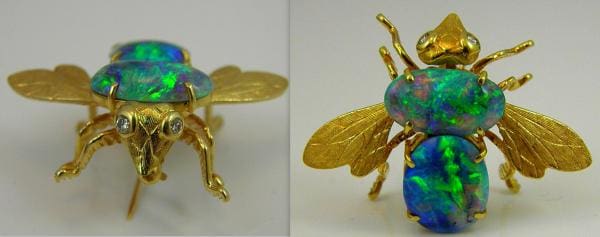
A piece from Brandon’s insect pin collection- a Rosenthal Bee set with Opals and Diamonds
My love of insect and animal jewelry is not surprising. Since childhood I have been fascinated with things that crawl- insects, arachnids, reptiles, you name it. I certainly have never shied away from getting dirty and exploring nature. I could spend whole days of my youth catching creatures, inspecting their fine details and reading about them in the encyclopedia only to release them later. It certainly contributed to my later degree in Microbiology. So you can imagine my surprise and pleasure when I learned that there is a whole category of figural jewelry made to resemble insects and animals, combining two of my passions. Figural jewelry is a category of jewelry loosely defined as pieces that are formed into figures that represent a form or shape, typically from nature or real life. Read on below for a history of figural jewelry, and to learn more about insect jewelry, animal jewelry, and how to identify and value these pieces.
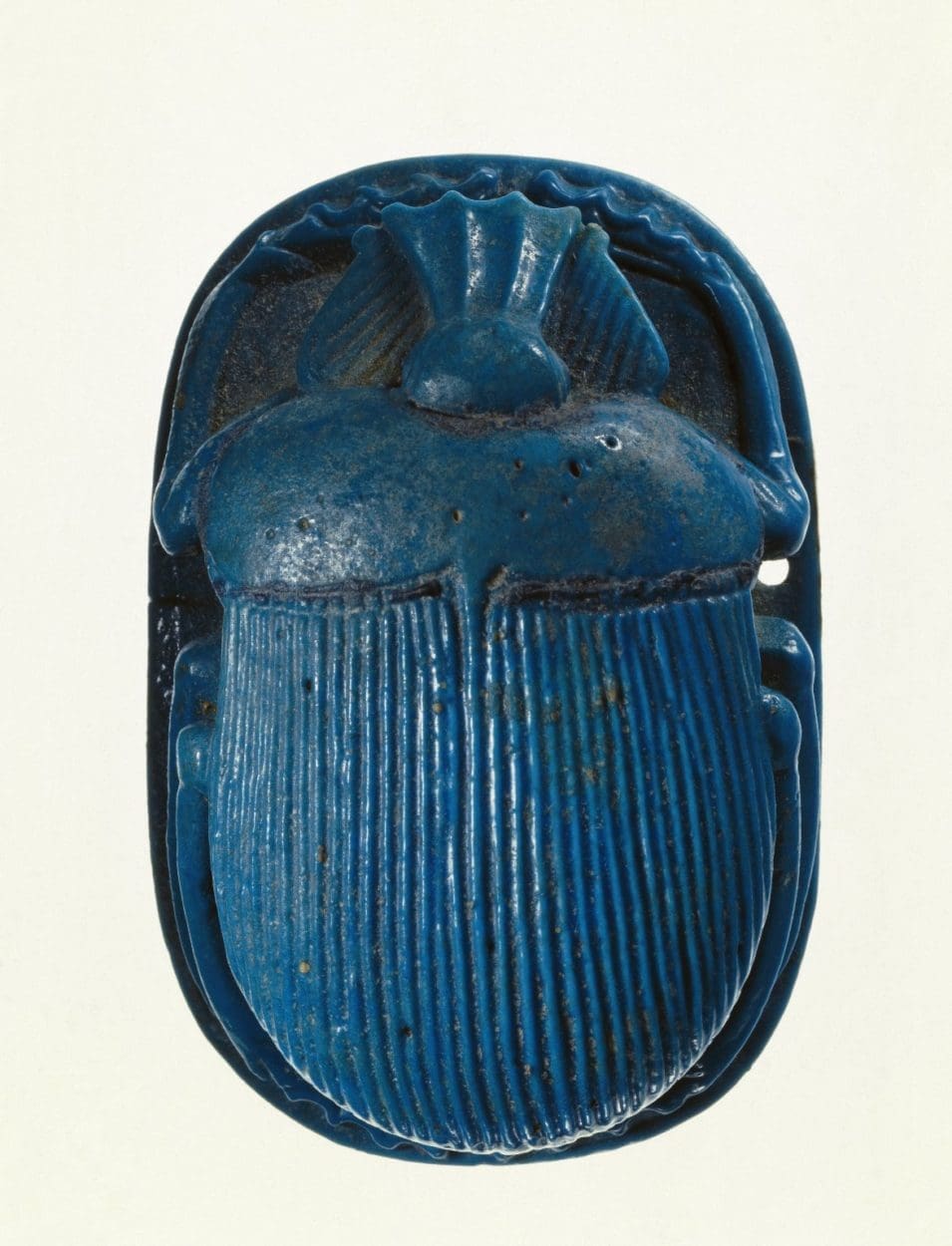
Egyptian Carved Faience Scarab Bead
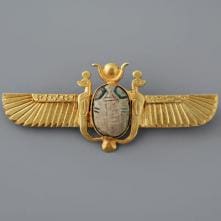
Ancient Egyptian Faience Scarab Carving finds a new home in this 1920’s gold Egyptian Revival Brooch.
The figural jewelry phenomenon has roots going back thousands of years to ancient times. Egyptians and Mesopotamians revered scarab beetles and other beneficial insects, which were often depicted in their artwork, including in their carved stone jewelry and gold trimmings. In India, the moth and butterfly were symbolic of the Buddhist belief in rebirth and re-incarnation, and jewels have been found going back hundreds of years that represent different stages in the life of a butterfly. In Europe, snakes were often seen in rings and brooches as symbols of fertility.
These figural jewels became more prevalent in the 1800s. European exploration of ancient sites in former Greek and Roman areas popularized archaeological revival jewelry, which often featured animals and insects. In the late Georgian and early Victorian years, circa 1790-1850, English and French interest in Egypt via6 the Napoleonic Wars, English settlement and eventual building of the Suez Canal, lead a renewed interest in Egyptology. Many wealthy British families would proudly purchase and display Egyptian artefacts, including carved Scarabs and other amulets worn as jewelry. Throughout the 19th century, Europeans traveled to northern Africa and explored archaeological sites, further popularizing Egyptian themes in jewelry. The most popular of these motifs was the scarab beetle- which had been a good luck symbol in ancient Egypt. Artists carved semiprecious stones to look like scarabs, or used original faience scarabs found in toms, and even actual Scarab beetle shells in jewelry. Other ancient motifs would be used as accents, in pieces we now call Egyptian Revival.
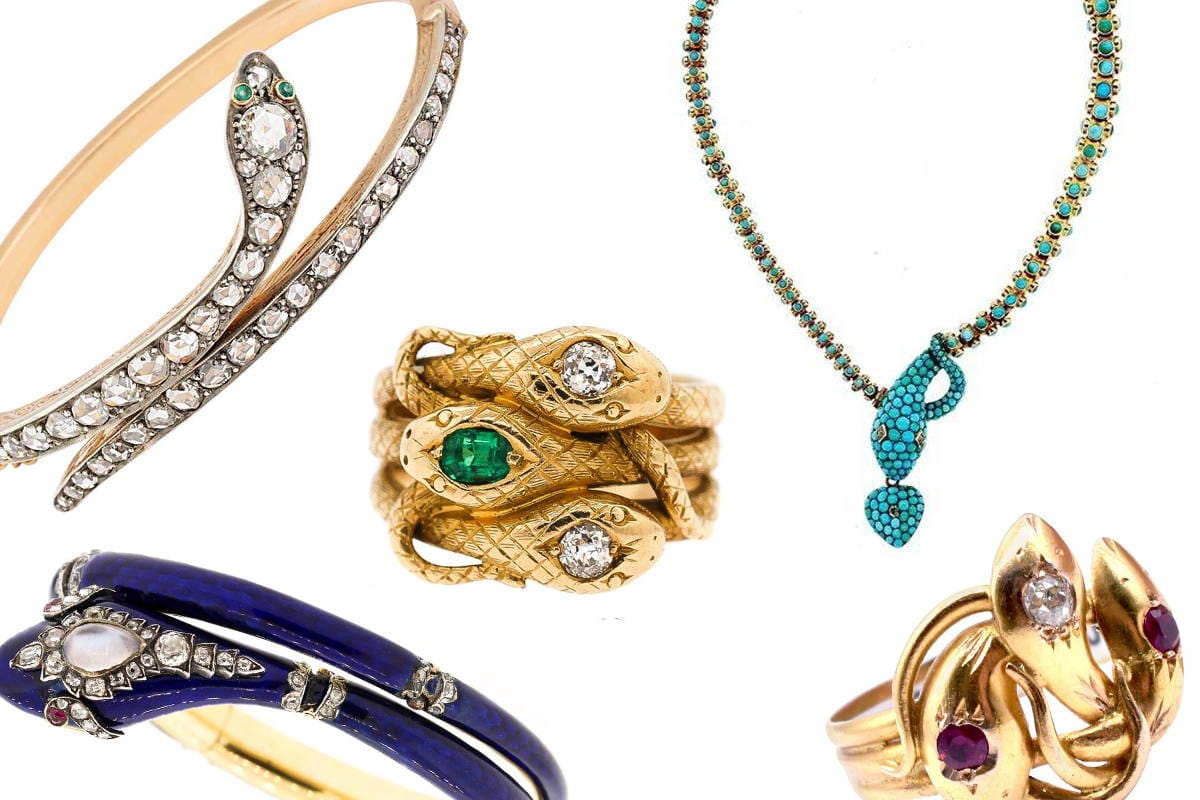
Victorian Snake Jewelry, including rings, bracelets, and necklace.
When Queen Victoria married Prince Albert in 1840, her wedding ring was a coiled snake with a Diamond head and Ruby eyes. The symbolism was that of the never ending ouroboros- a love that is natural and has no beginning or end. Since Victoria ruled over half the world and was considered the first global celebrity, she greatly influenced fashion, and her snake ring popularized all things serpents and snake jewelry for years to come. Snake rings became the ultimate gift of love. Later in the Grand Period of the Victorian era, between 1860 and 1885, other insects and animals became popular. During this time we first started to see spiders, flies, moths, and bees used as earrings, brooches and rings; along with lizards, birds, frogs and other small creatures in brooch and pendant form. The Victorian examples of figural jewelry tended to be larger than earlier or later versions, and the jewelers making them often did not have the real thing in front of them, so sometimes the figures could look a bit naïve, with less attention paid to accurate portrayal. For example, we see bees with tiny wings, snakes with giant fangs, etc., often encrusted with pearls or Diamonds, and set with gems to add sparkle and glamour to the piece. The Victorians saw a true sense of mystery in the natural world, and the figural pieces from this time capture that imagination. Sometimes the bodies of the insects would be large gemstones, other times the piece would be pearl or diamond encrusted, and sometimes the items were simply carved from silver. In France, where bees were the emblem of Prince Victor Bonaparte, all of the fashionable ladies had to have a patriotic bee brooch. A few examples of Grand Era insects are pictured below.
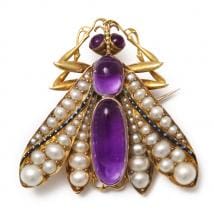 |
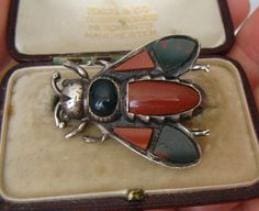 |
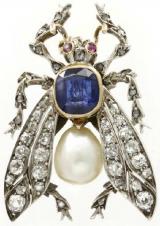 |
These early renditions of figural jewelry inspired many jewelers in the Art Nouveau and Edwardian period that followed, roughly from the 1890s-1915. The difference between the jewelry made during these eras is drastic. The Victorian pieces were chunky, with lots of character- crafted more for sentimental whimsy than realism. The love of nature that blossomed after the turn of the century was more refined. Advances in jewelry technology allowed craftsman like Rene Lalique and Louis Comfort Tiffany to play with complex enameling, new metals white gold and platinum, as well as different gemstones such as opals, tourmalines and garnets. In addition, people of the time developed an intense fascination with the natural world, God’s creations, and much respect was paid to nature’s forms.
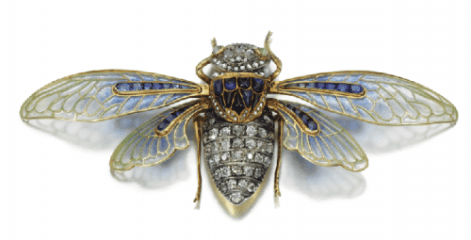
Lalique winged beetle brooch circa 1910 with enamel and gemstones.
The more realistic the interpretation of the animal or insect, the better! Insect pieces from the Art Nouveau period tend to be the most collectable, as they have a beauty and realism that is impossible to replicate. The winged beetle, below left, shows the incredible enamel work of French jeweler Lalique, and the two images below right show work from the same era but made in Great Britain and America- with more emphasis on gems and diamonds. Note the importance of realism- segmented bodies and legs, true to size wings, antennae and papillae, all crafted from gold and silver and set with a myriad of fabulous gems.
 |
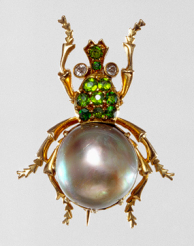 |
Figural jewelry took a back seat to more classic and modern styles in first half of the twentieth century, with a few notable exceptions- think Tiffany’s Bird on a Rock, or Cartier’s Art Deco Figural Charm Bracelets. Figurals came roaring back from the 1950s to the 1970s, in every price point and for every occasion. Companies like Trifari championed the “jelly belly” which was a series of animals and whimsical characters in their costume jewelry line, which are some of the most collected brooches today. Wearing multiple small brooches on scarves or a chunky piece on a lapel was all the rage. Costume jewelers sold these pieces by the thousands, and fine jewelers followed suit.
By the late 1960s, figural jewelry was big business, especially insects. It brings to mind one of my favorite jewelry history lessons. A New York jeweler named Herbert Rosenthal, known for elaborate and costly brooches (and maker of my opal bee at the top of this page), trademarked his designs for bejeweled bees and flies. He had a boutique on 5th avenue and sold them
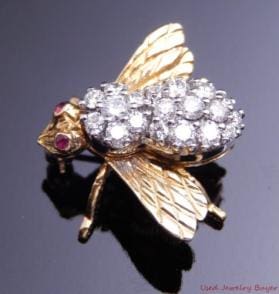
Rosenthal Diamond Bee Brooch, circa 1970
to all the rich and famous. They became so popular that other firms started making similar designs to meet demand, especially at lower price points. In response, Rosenthal sued these other jewelers for design infringement. The legal posturing went back and forth, and ultimately the case ended up in the US Supreme Court. It was decided that, while the other brooches were surely imitations of Rosenthal’s designs, and that his intellectual property rights had been infringed, Rosenthal should not have been granted a trademark in the first place! Thus Rosenthal lost his case, and the other firms continued making similar pieces (a selection of these is found at the bottom of the page). The reasoning behind the decision was sound: bees are of natural origin and a design that belongs to everyone, not a unique design or motif created by Rosenthal, and he had not done enough to change the design from the natural form to argue that his design was in any way unique. Despite his loss, and maybe because of the interesting story, Rosenthal pieces are especially collectable today.
Figural pieces have continued to be popular, especially now that the fashion world emphasizes larger statement jewelry. The majority of the more recent pieces take the form of pins and brooches, but we also see some rings and pendants too. In the past few years, we have sold a wide array of antique and estate figural jewels. Each piece has character and becomes a treasured piece of the owner’s jewelry wardrobe. In addition, as a full custom shop, we have also been asked to craft some amazing figural pieces! In recent memory, we have made fish rings, lizard brooches, dog pins, octopus bracelets, parrot brooches, skull pendants, hydra rings and many more. The below custom hummingbird necklace is a great example. We made it the same way a jeweler would have in 1910, with the help of modern CAD technology. The client came to us with a group of heirloom pieces from which she wanted to use the Diamonds and gemstones to make a single custom piece, in the shape of her favorite animal, the Anna’s Hummingbird. We used real photographs of the birds and CAD to create the design, then modified it to fit her gems. We then cast the piece using recycled gold, and set her gemstones into place, finishing it by attaching her favorite gold chain. The necklace is alive the character- the perfect example of a modern figural piece.
If you are looking to shop our collection of antique and estate figurals, or maybe you want to have your spirit animal made, then stop by chat with one of our jewelry experts.
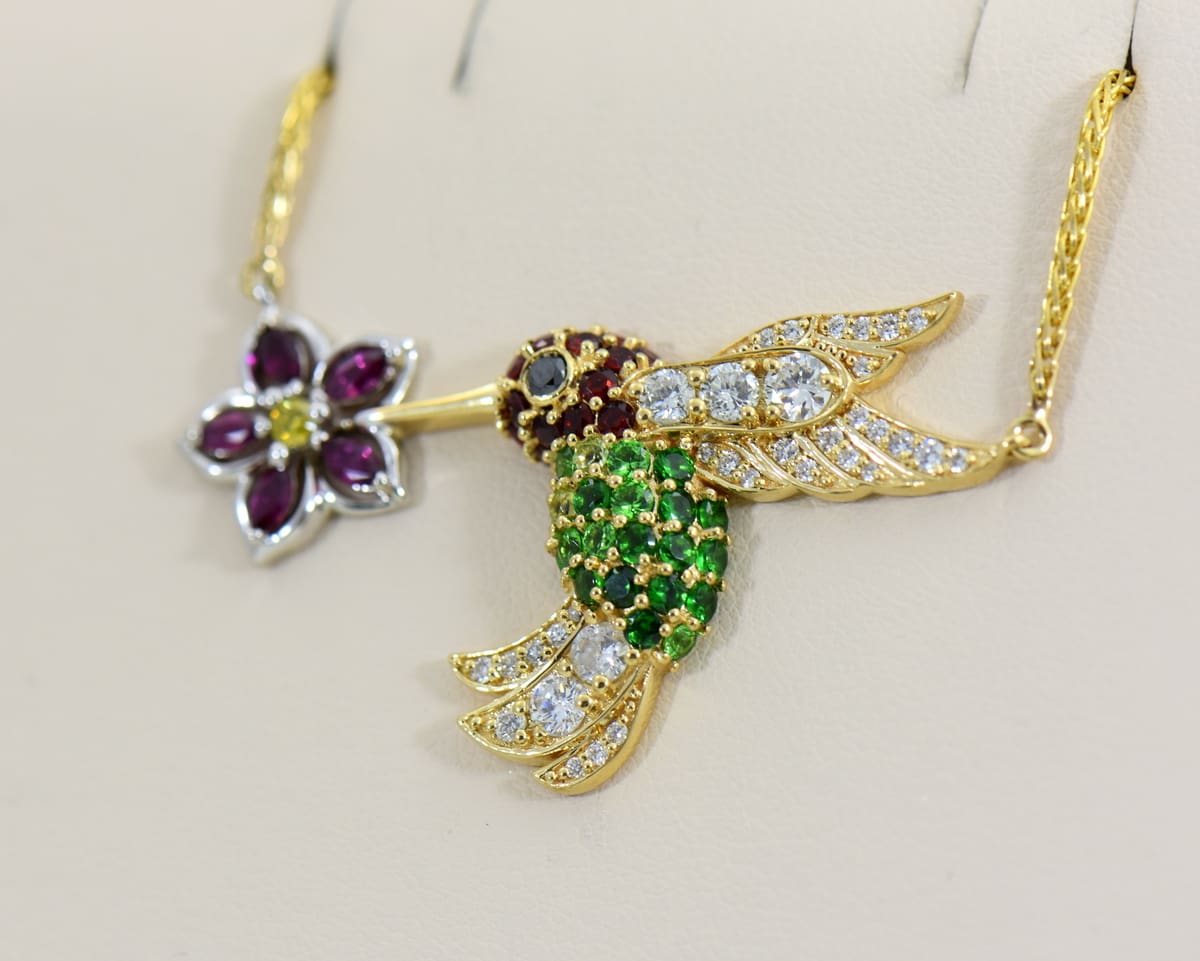
FWCJ original custom Hummingbird pendant set with client’s heirloom gems and Diamonds.
Stop by our store to see our ever-changing insect jewelry, or contact us to learn more.
